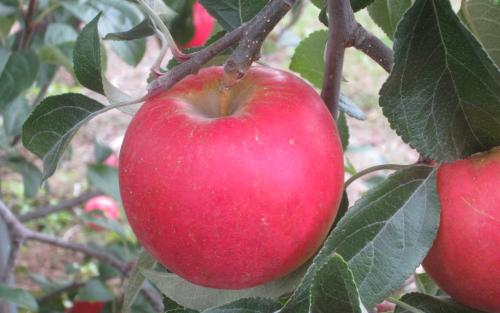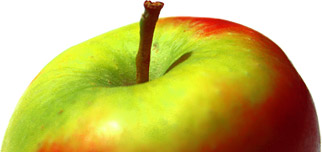
Pixie Crunch™is a trademark of Purdue University.
Pixie Crunch apple identification images
All images copyright Orange Pippin unless otherwise stated.
USDA identification images for Pixie Crunch
The identification paintings in the USDA Pomological Watercolor Collection span the years 1886 to 1942.
Citation: U.S. Department of Agriculture Pomological Watercolor Collection. Rare and Special Collections, National Agricultural Library, Beltsville, MD 20705.
Parents and other ancestors of this variety
Visitor reviews
- 17 Aug 2021 CA, United StatesBreaking, crisp, very juicy, with remarkably yellow flesh. Delightful to have a few bites of such a nice apple. Heavy fruiting every year. Here in Walnut Creek, CA, it suffers quite a bit from fire blight, but most branches stayed healthy this spring. My tree is growing on M27 rootstock. Despite thinning, a couple of branches have broken from the weight of the fruit.
- 02 Feb 2020 ID, United StatesPixie Crunch is one of my new favorites. It has a unique crisp breaking, crunchy texture unlike any other apple I have tried, and the flavor is very good and sweet. This was the first year my tree produced and it set a heavy crop despite a late frost that reduced the production of many other varieties I grow. I will look forward to this apple year after year.
- 12 Oct 2019 WISCONSIN, United StatesJust discovered the Pixie Crunch at an orchard in Illinois. It's just what I've been looking for - the juice and crunch of a Honeycrisp with the sweetness and smaller size of Jonathon's or McIntosh. I don't know about growing them, but I will continue to eat these for a long time. Good job, Purdue, for hybridizing this fruit.
- 09 Jul 2018 CALIFORNIA, United StatesI've grown 8 of these trees over the years, 3 on M7 and 5 on G30... all in North Carolina. While fireblight and cedar-apple rust can be severe, they can be grown in the Southeast with a good fungicide/insecticide program. They have a great flavor and the crispness is exceptional. Of the over 50 kinds of apples I have grown, this was the most popular with folks. It is among my top 10 favorite apples for fresh eating.
- 25 Jun 2018 KY, United StatesI planted 5 varieties at the same time - 2 disease resistant, 2 heirloom and the Pixie Crunch. Cedar apple rust and fireblight are problems here and the Pixie Crunch needed more attention than the others put together. Since my goal was as low maintenance as possible, the tree had to go. It already had half the limbs removed due to fireblight and the rest of the leaves all showed cedar apple rust even after being on a spray schedule.
- 22 Feb 2018 WV, United StatesI purchased a dwarf Pixie Crunch a few years back. The first year it produced one Apple, which was very crisp and sweet. The following winter was harsh and a heavy snowfall broke the tree off at the ground. I have since purchased another one which is growing very well and hopefully will produce some fruit this year. I love the crispness and the sweet, juicy flavor of this apple.
- 30 Jul 2017 OH, United States2nd year. Let 4 apples grow. Waiting to mature
- 14 Sep 2016 PA, United StatesSmall fruit with a great hard, crisp, breaking texture. A bit more dense and a bit sweeter than Honeycrisp. An average amount of juice, not great complex flavor but very good. Classic apple flavor with a bit grassy smell.
- 28 Oct 2015 IL, United StatesWhat nice little apple. Crisp, with a nicely balanced sweetness and a lovely perfume. Perfect size for a linch box or for after dinner with wanuts and cheese.
- 27 Jan 2012 PA, United StatesThese apples are crisp, juicy, sweet, slightly tart. A great lunch box apple: small, and delicious.
Tree register
United States
- Adam Dupps in Lawrenceburg, IN
- Albany Appleguy in Castleton, NY
- Anton in Pittsboro, NORTH CAROLINA
- Bcarp001@Yahoo.Com in PINE CITY, MN
- Caroline Haggarty in MILLIS, MA
- Cheri in Plover, WISCONSIN
- Chris Thomas in Federal Way, WASHINGTON
- dam40s@hotmail.com in Holly Hill, FLORIDA
- David Methven in Rural Ridge, PA
- Don Mcivor in Twisp, WA
- Don Mcivor in Twisp, WA
- Francis Goretski in Wilkes Barre, PA
- Gene Prince in Baton Rouge, LOUISIANA
- Gil Schieber in Snohomish, WASHINGTON
- Jason in San Diego, CA
- Jason Long in Papillion, NE
- Jeff Fournier in Alger, MI
- Joe & Rachel Bender in ALBION, INDIANA / NOBLE
- Joshua in Port Deposit, MD
- Karla in Littleton, COLORADO
- Kekozlow in WHITING, IN
- Kyle Franke in Kenmore, NY
- Michael Mccrary in Columbus, OH
- Michael Miller in Kennett Square, PA
- Peter in Johnson City, TN
- Peter Wildenhaus in Strongsville, OH
- Randall Cherry in Reading, PENNSYLVANIA
- Rob Bryant in Monticello, IN
- Robert Bratsch in PLYMOUTH, MN
- Steve in Silver Spring, MD
- Steven Sypkens in TURNEY, MO
- Ted S. in Reading, PA
- Thomas Griffith in Cottage Grove, WI
- Tom Keliher in Perryville, MISSOURI
- Wendy p in Dallas, OREGON
France
- Richard Borrie in Objat,
Australia
- Hayden in Winslow, VICTORIA, AUSTRALIA
Spring blossom records for this variety
2025 season
- 8th April 2025 - tree owned by Richard in Objat, France
2017 season
- June 2017 - tree owned by Jason in San Diego, United States
- 3rd April 2017 - tree owned by Anton in Pittsboro, United States
2016 season
- 15th May 2016 - tree owned by Jason in San Diego, United States
2014 season
- 15th May 2014 - tree owned by Francis in Wilkes Barre, United States
- 13th May 2014 - tree owned by Don in Twisp, United States
2013 season
- May 2013 - tree owned by Tom in Perryville, United States
- May 2013 - tree owned by Cheri in Plover, United States
- 10th April 2013 - tree owned by Gil in Snohomish, United States
2012 season
- May 2012 - tree owned by Tom in Perryville, United States
- April 2012 - tree owned by Cheri in Plover, United States
Record your blossom dates in our Fruit Tree Register - more >>.
Harvest records for this variety
2018 season
- 3rd week September 2018 - tree owned by David in Rural Ridge, United States
2017 season
- 1st week September 2017 - tree owned by Anton in Pittsboro, United States
2016 season
- 2nd week September 2016 - tree owned by David in Rural Ridge, United States
2015 season
- 3rd week September 2015 - tree owned by Jeff in Alger, United States
2013 season
- 2nd week October 2013 - tree owned by Cheri in Plover, United States
- 2nd week October 2013 - tree owned by Gil in Snohomish, United States
2012 season
- September 2012 - tree owned by Tom in Perryville, United States
Origins
- Species: Malus domestica - Apple
- Parentage: PRI 669-205 x PCF 2-134
- Originates from: United States
- Introduced: 1993
- Developed by: PRI (Purdue, Rutgers, Illinois Co Op)
Identification
- Country of origin: United States
- Period of origin: 1950 - 1999
- Fruit colour: Red
- Flower colour: White
- Leaf colour: Green
- Popularity: Best sellers
- Annual cycle: Deciduous
Using
- Picking season: Mid
- Keeping (of fruit): 1-2 months
- Flavour quality: Very good
- Flavour style (apples): Sweet/Sharp
- Cropping: Good
- Fruit persistence: Ripens over a period
- Food uses: Eating fresh
- Wildlife: RHS Plants for Pollinators
Growing
- Gardening skill: Beginner
- Flowering group: 4
- Pollinating others: Average
- Ploidy: Diploid
- Vigour: Average vigour
- Bearing regularity: Biennial tendency
- Fruit bearing: Spur-bearer
- Organic culture: Suitable
- Self-fertility: Not self-fertile
- Feathers on maiden: Often has feathers
Climate
- Climate suitability: Temperate climates
- Climate suitability: Warm climates
- Summer average maximum temperatures: Cool ( 20-24C / 68-75F)
- Summer average maximum temperatures: Warm (25-30C / 76-85F)
Other qualities
- Disease resistance: Good
- Scab (Apple and Pear): Very resistant
- Powdery mildew: Some susceptibility
- Fire blight: Some susceptibility
- Cedar apple rust: Very susceptible
Where to buy trees
The following tree nurseries offer Pixie Crunch apple trees for sale:
- Orange Pippin Fruit Trees (USA) United States
Pixie Crunch apple trees
Where to buy fresh fruit
The following orchards grow Pixie Crunch:
United States
Colorado
- Masonville Orchard, Fort Collins
Indiana
- Harker Family Farms & Orchard, Waldron
Maine
- Plowshares Community Farm, Gorham
Michigan
Ohio
- Lynd Fruit Farm, Pataskala
Pennsylvania
- Miles Orchard (Miles Farm Produce), Coudersport
Washington
- Skipley Farm, Snohomish *** Feature Orchard ***
Wisconsin
- Door Creek Orchard, Cottage Grove
References
- PRI Coop 33 variety description
1993
Author: PRI

